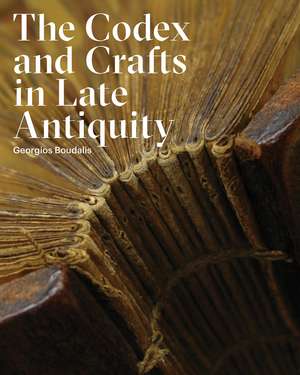The Codex and Crafts in Late Antiquity
Autor Georgios Boudalisen Limba Engleză Paperback – 15 iul 2020
The transition from roll to codex as the standard format of the book is one of the most culturally significant innovations of Late Antiquity. The Codex and Crafts in Late Antiquity examines surviving evidence in order to better understand how this transition took place. Placing the codex into the general cultural, religious, and technological context of Late Antiquity, the book examines the major types of codices—the wooden tablet codex, the single-quire codex and the multi-quire codex—in all their structural, technical, and decorative features. Georgios Boudalis argues that the codex was not an ingenious invention but rather an innovation that evolved using techniques already widely employed by artisans and craftspeople in the creation of everyday items such as socks, shoes, and baskets, revealing that the codex was a fascinating, yet practical, development.
Preț: 174.86 lei
Nou
Puncte Express: 262
Preț estimativ în valută:
33.46€ • 35.03$ • 27.69£
33.46€ • 35.03$ • 27.69£
Carte disponibilă
Livrare economică 15-29 martie
Livrare express 04-08 martie pentru 29.17 lei
Preluare comenzi: 021 569.72.76
Specificații
ISBN-13: 9781941792124
ISBN-10: 194179212X
Pagini: 200
Ilustrații: 32 color plates, 80 halftones, 45 line drawings
Dimensiuni: 178 x 222 x 15 mm
Greutate: 0.5 kg
Editura: BARD GRADUATE CENTER
Colecția Bard Graduate Center
ISBN-10: 194179212X
Pagini: 200
Ilustrații: 32 color plates, 80 halftones, 45 line drawings
Dimensiuni: 178 x 222 x 15 mm
Greutate: 0.5 kg
Editura: BARD GRADUATE CENTER
Colecția Bard Graduate Center
Notă biografică
Georgios Boudalis is the senior book and paper conservator at the Museum of Byzantine Culture, Thessaloniki, Greece.
Cuprins
Director’s Foreword
Foreword
Acknowledgments
Introduction: The Innovation of the Codex in Late Antiquity
Part I: The Precursors of the Multigathering Codex
One: The Wooden Tablet Codex
Two: The Single-Gathering Codex
Part II: The Multigathering Codex
Three: The Multigathering Codex: Introduction
Four: The Sewing of the Gatherings
Five: The Boards and Their Attachment
Six: The Spine Lining
Seven: The Endbands
Eight: The Cover and Its Decoration
Nine: The Fastenings
Ten: The Bookmarks and Board Corner Straps
Conclusion
Checklist of Objects in the Exhibition
Bibliography
Index
Foreword
Acknowledgments
Introduction: The Innovation of the Codex in Late Antiquity
Part I: The Precursors of the Multigathering Codex
One: The Wooden Tablet Codex
Two: The Single-Gathering Codex
Part II: The Multigathering Codex
Three: The Multigathering Codex: Introduction
Four: The Sewing of the Gatherings
Five: The Boards and Their Attachment
Six: The Spine Lining
Seven: The Endbands
Eight: The Cover and Its Decoration
Nine: The Fastenings
Ten: The Bookmarks and Board Corner Straps
Conclusion
Checklist of Objects in the Exhibition
Bibliography
Index
Recenzii
"Boudalis, senior conservator at the Museum of Byzantine Culture in Thessaloniki, Greece, builds on past scholarship to argue that the multi-gathering codex, the traditional book, emerged from contemporary technology and skills from existing disciplines. . . . This volume is well illustrated with photographs and with drawings by the author, and documentation is extensive, including a detailed bibliography. In addition, a checklist of objects included in an exhibition on the development of the codex book mounted at Bard College, where the author was a visiting scholar, is appended."
"Boudalis has some surprising things to say about the origins of the codex. It supplanted the scroll between the second and sixth centuries AD but did not emerge sui generis as a game-changing invention. Rather, it was a sideways move, adapting not only existing writing technologies – tablets and parchment – but also socks, baskets, shoes and belts. Such utilitarian objects were made using the same techniques of weaving, stitching and leatherwork – and often the same craftspeople – as the 'multi-gathering codex.' The distinctive 'coptic knitting' used to make socks was adapted to stitch pages together, while weaving techniques of ancient Egyptian curtain fabrics are also found in endbands at the top and tail of the book’s spine. Seeing these items side by side gives us a fresh perspective on the book: it’s a craft artefact, as Boudalis argues, anchored in the material culture of the ancient world. This allows some illuminating connections to be made."
"Boudalis’s superb drawings go much further than any photograph in conveying complex information."
